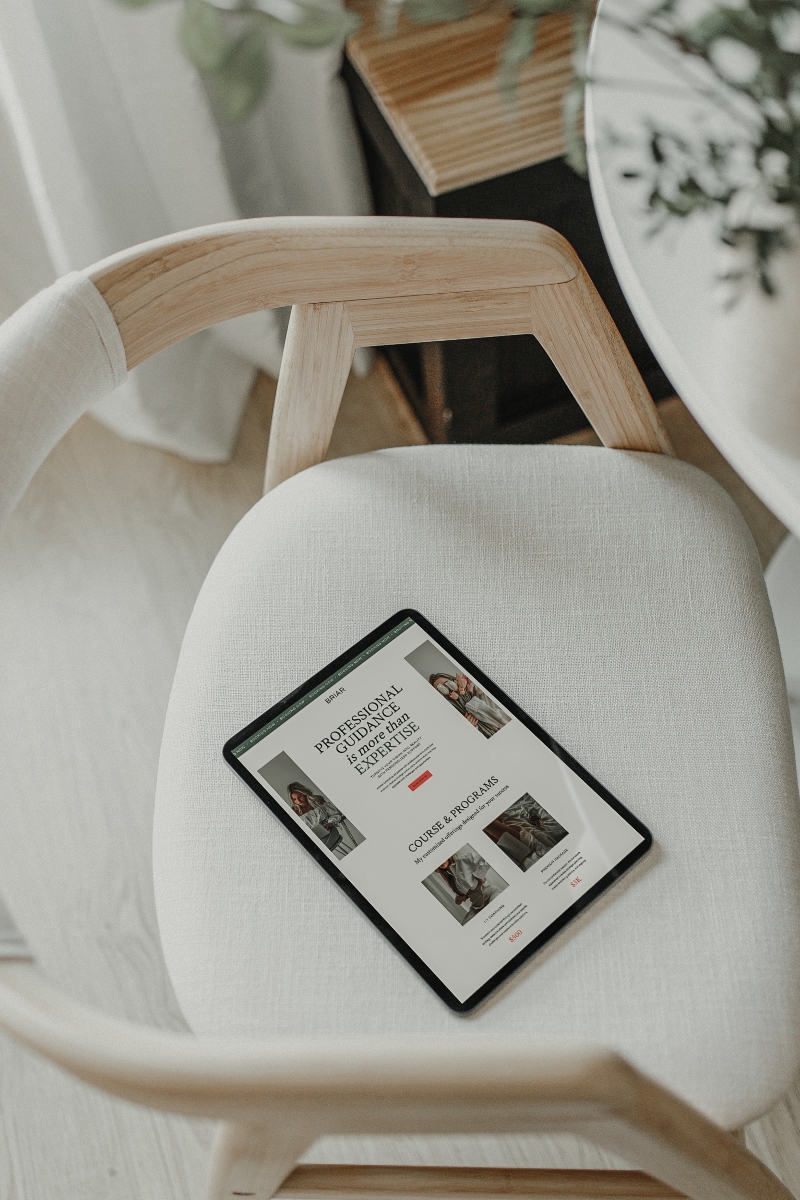A step-by-step guide for coaches who want a professional website without the designer price tag
You know you need a professional website for your coaching business. The problem? Every time you start researching how to create your own business website, you get overwhelmed by technical jargon, conflicting platform recommendations, and the nagging fear that you’ll accidentally break something important.
Here’s what usually happens: You bookmark seventeen different tutorials, start three different free trials, and end up with a half-finished website that looks like it was assembled by a committee of confused robots.
Sound familiar?
Let me be clear about something upfront: creating your own business website doesn’t require a computer science degree. It doesn’t even require knowing what HTML stands for (though if you’re curious, it’s HyperText Markup Language—see, totally unnecessary information).
What it does require is a strategic approach that puts your coaching business first and the technical stuff second. As a web designer who helps coaches build websites that actually convert visitors into clients, I’m going to walk you through exactly how to create a professional website that serves your business goals—not just your perfectionist tendencies.
Table of Contents

Why DIY Doesn’t Have to Mean “Do It Alone”
The biggest mistake coaches make when building their own website is thinking “DIY” means figuring everything out from scratch. That’s like saying you’re going to build your own house and then trying to mine the iron ore for your nails.
Smart DIY means leveraging the right tools, templates, and guidance to get professional results without the professional learning curve.
Here’s the reality: Professional web designers aren’t successful because they know secret code. They’re successful because they understand what works, what doesn’t, and how to implement proven strategies efficiently. You can access those same strategies through well-designed templates and strategic guidance.
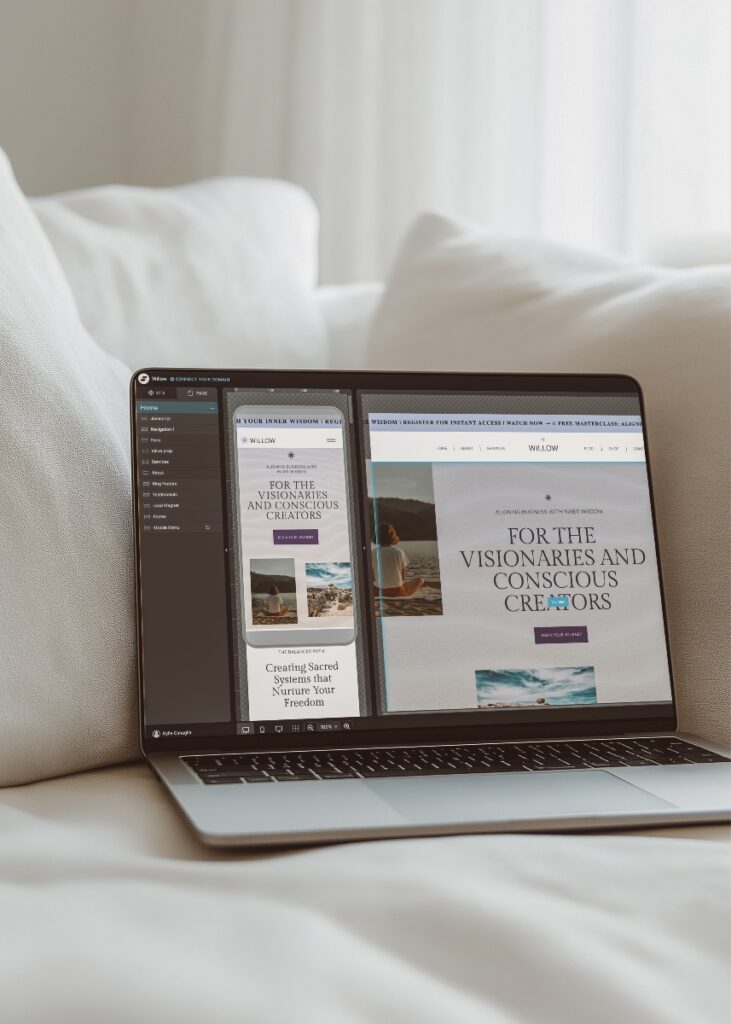
The “I Need to Learn Code” Myth
Some coaches think they need to learn HTML, CSS, and JavaScript before they can build a website. This is like thinking you need to understand internal combustion engines before you can drive a car.
Modern website builders—especially platforms like Showit that I use and recommend—handle all the technical complexity behind the scenes. You focus on your content and design choices. The platform handles making it work on phones, tablets, and computers.
Template vs Custom: Why Templates Are Actually Strategic
“But won’t my website look like everyone else’s if I use a template?”
This question comes from a fundamental misunderstanding of how professional templates work. A well-designed template isn’t a rigid box you’re stuck with—it’s a strategic framework that handles the complex stuff (layout, mobile responsiveness, conversion optimization) so you can focus on the uniquely you stuff (your content, your photos, your brand personality).
Think of it like buying a well-designed house versus building from scratch. The house already has plumbing and electrical work done by professionals. You get to focus on paint colors, furniture, and making it feel like home.
Plus, here’s something most people don’t realize: even multi-million dollar companies use templates and frameworks. They just customize them strategically.
Choosing the Right Platform for Your Coaching Business
Not all website builders are created equal, especially when you’re building a coaching business that needs to convert visitors into consultation bookings.
Let me save you weeks of research: I use and recommend Showit for coaches, and here’s why it’s become my go-to platform after testing virtually everything available.
Why Showit Is Perfect for Coaches
Drag-and-Drop Simplicity That Actually Works Showit lets you move elements around your page like you’re arranging furniture in a room. No coding, no breaking things accidentally, no wondering why your text disappeared when you tried to add a photo.
Design Freedom Without Technical Complexity Unlike other platforms that lock you into rigid templates, Showit gives you complete design control while handling all the technical requirements automatically. Your website will look exactly how you envision it, but it’ll work perfectly on every device without you having to think about it.
Built for Conversion Showit was designed with business owners in mind. Features like seamless contact form integration, easy call-to-action placement, and conversion-focused templates help turn your website visitors into paying clients.
SEO That Actually Works Showit handles the technical SEO requirements automatically while giving you easy control over the elements that matter for ranking in search results.
Platform Comparison: What You Actually Need
Here’s how the major platforms stack up for coaching businesses:
WordPress: Powerful but complex. Great if you want to become a part-time web developer. Overwhelming if you just want to help people transform their lives.
Squarespace: Beautiful templates but limited customization. Like buying a gorgeous outfit that almost fits but can’t be tailored.
Wix: Easy to start but hard to scale. Your website might look great until you need to add booking systems, email integration, or advanced features.
Showit: The sweet spot between ease and power. Designed for business owners who want professional results without technical headaches. (And, bonus, incorporates the powerful blogging capabilities of WordPress!)
For coaches specifically, Showit wins because it’s built around how coaching businesses actually operate—not generic website needs.
Planning Your Website Before You Build (The Step Everyone Skips)
Most coaches jump straight into choosing colors and fonts without doing the strategic work first. This is like decorating a house before you’ve decided how many bedrooms you need.
Here’s what happens when you skip the planning phase: you end up with a pretty website that doesn’t actually serve your business goals. Visitors land on your homepage, wander around confused, and leave without booking a consultation.
The solution? Plan your website around your ideal client’s journey, not your personal design preferences.
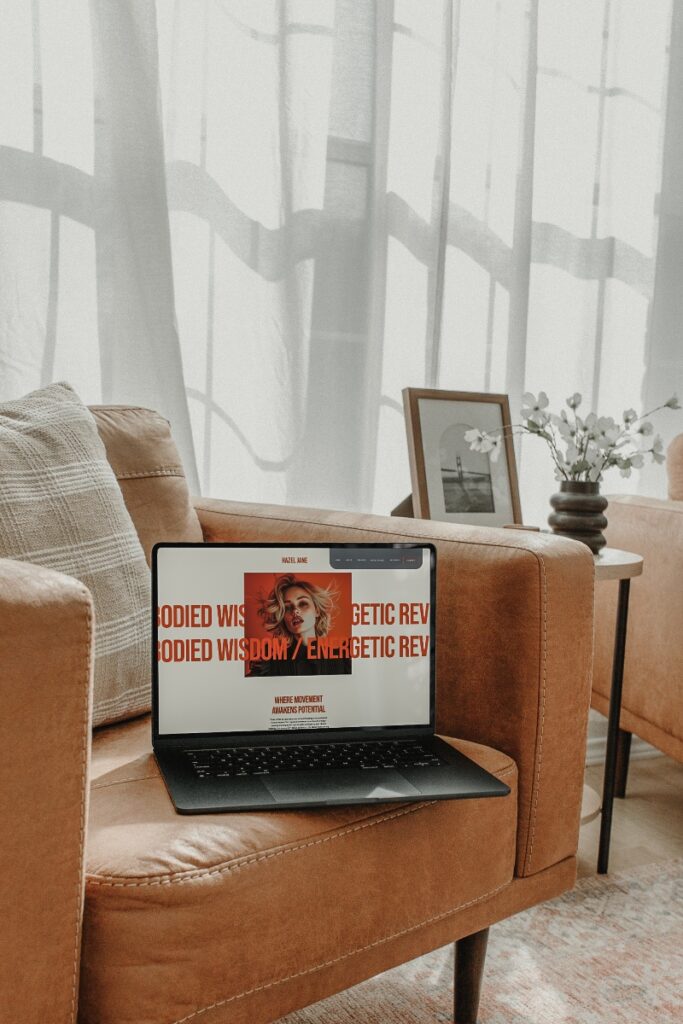
Your Client Avatar Drives Everything
Before you pick a single design element, get crystal clear on who you’re trying to attract. Not “anyone who needs coaching,” but the specific person whose problems you solve best.
Ask yourself:
- What does a typical day look like for your ideal client?
- What problem brought them to Google searching for a solution?
- What concerns or objections might prevent them from booking a consultation?
- What would convince them that you’re the right coach for their situation?
These answers shape everything from your headline to your color choices. A executive coaching website for C-suite professionals looks very different from a life coaching site for overwhelmed mothers—and it should.
Mapping the Client Journey on Your Site
Your website isn’t a brochure—it’s a sales process. Map out the path you want visitors to take:
- They land on your homepage (usually from Google or social media)
- They quickly understand what you do and who you help
- They start to believe you can solve their problem (through your about page, testimonials, or content)
- They take the next step (book a consultation, join your email list, or download a resource)
Every page on your website should move people forward in this journey, not just provide information.
Essential Pages Every Coach Needs (And Why You Need Them)
Most coaches either include too many pages (overwhelming visitors) or too few (missing conversion opportunities). Here’s what you actually need:
Homepage: Your Digital Front Door
Your homepage has one job: help visitors quickly understand what you do and decide whether to explore further.
Essential elements:
- Clear headline that speaks directly to your ideal client’s situation
- Subheadline that explains how you help solve their problem
- Professional photo that builds trust and connection
- Social proof (testimonials or client results)
- Clear next step (book a consultation, learn more, etc.)
Common mistake: Trying to include everything on your homepage. Instead, think of it as a movie trailer—give people enough information to want to see the full story.
About Page: Where Trust Gets Built
Here’s a little secret: your about page is often the most-visited page on your website. People want to know who you are before they trust you with their problems.
What to include:
- Your story (especially the part that relates to why you became a coach)
- Your credentials and experience
- Your coaching philosophy or approach
- Why you’re passionate about helping your specific type of client
- Another professional photo (people need to see you to trust you)
What to avoid: A boring resume or autobiography. Focus on the parts of your story that help potential clients believe you understand their situation.
Services Pages That Actually Sell
Many coaches create services pages that read like grocery lists: “I offer 1:1 coaching, group programs, and workshops.” That tells visitors what you do, but not why they should care.
Instead, structure your services around the transformation you provide:
- What their life looks like now (the problem)
- What their life could look like (the solution)
- How you bridge that gap (your process)
- What’s included (the logistics)
- How to get started (clear next step)
Each service should feel like the obvious solution to a specific problem your ideal client faces.
Design Principles That Convert Visitors to Clients
Good design isn’t about following the latest trends—it’s about creating an experience that builds trust and guides people toward working with you.
The Psychology of Color in Coaching Websites
Colors affect how people feel about your brand, often subconsciously. For coaching websites:
Blue conveys trust and stability (great for business or financial coaching) Green suggests growth and balance (perfect for life or career coaching) Purple implies wisdom and transformation (excellent for mindset or spiritual coaching) Warm colors (oranges, warm reds) feel energetic and approachable
The key isn’t picking the “right” color—it’s picking colors that match your brand personality and appeal to your ideal client.
Mobile-First Design (Because That’s Where Your Clients Are)
More than half of your website visitors will be on their phones. If your site doesn’t work well on mobile, you’re losing potential clients before they even read your content.
Mobile essentials:
- Text large enough to read without zooming
- Buttons big enough to tap easily
- Fast loading times (slow sites get abandoned)
- Simple navigation that works with thumbs
- Contact information that’s easy to find and use
The good news? Platforms like Showit handle mobile optimization automatically, so you don’t have to become a mobile design expert.
Writing Website Copy That Actually Works
This is where most coaches get stuck. You know you need compelling copy, but writing about yourself and your services feels awkward, overwhelming, or just plain impossible.
Here’s the thing: great website copy isn’t about being a brilliant writer. It’s about clearly communicating how you help people and why they should choose you over other options.
Headlines That Stop the Scroll
Your headline is the first thing visitors see and often determines whether they stay or leave. Great coaching headlines follow this formula:
[Specific Problem] + [Desired Outcome] + [Your Unique Approach]
Examples:
- “Overwhelmed Entrepreneurs: Build a Business That Supports Your Life (Not Consumes It)”
- “Finally Break Through Money Blocks and Build the Wealth You Deserve”
- “Transform Your Leadership Style and Create the Culture Your Team Actually Wants”
Notice how each headline speaks to a specific person with a specific problem and promises a specific transformation.
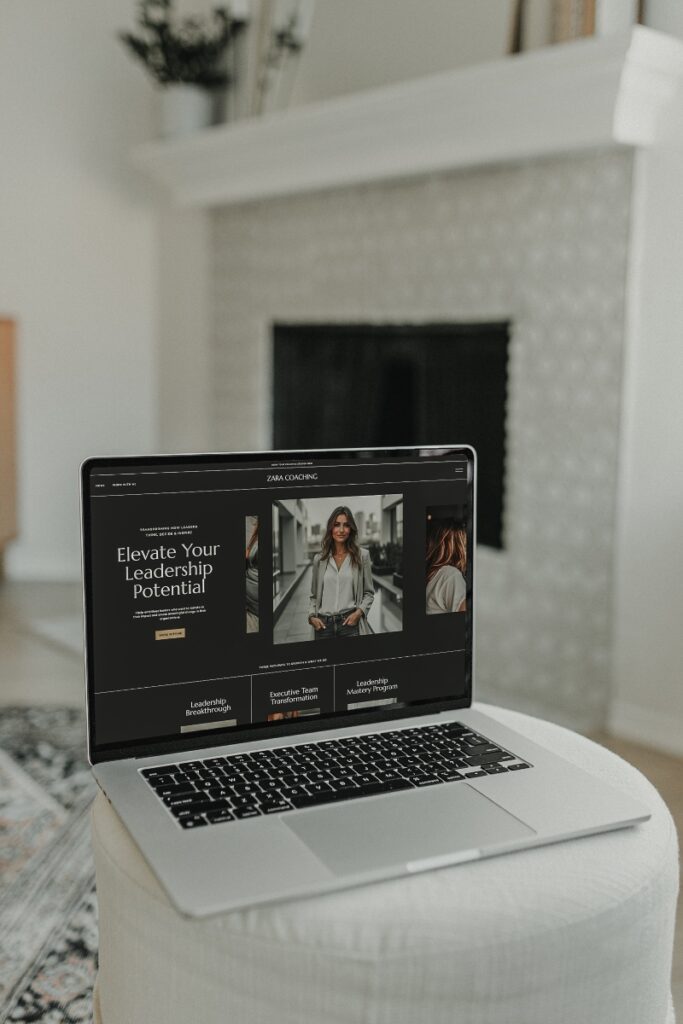
Turning Features Into Benefits Your Clients Actually Want
Features are what you do. Benefits are what your clients get. Your website should focus heavily on benefits.
Feature: “I offer weekly 1:1 coaching sessions” > Benefit: “Get personalized guidance and accountability to stay on track with your goals”
Feature: “I’m certified in Cognitive Behavioral Coaching” > Benefit: “Learn proven techniques to break negative thought patterns that keep you stuck”
Always answer the question: “So what? Why should I care?” from your client’s perspective.
Technical Setup Made Simple (No Code Required)
The technical aspects of building a website can feel intimidating, but modern platforms handle most of the complexity for you. Here’s what you actually need to know:
Domain Names That Work for Coaches
Your domain name (yourwebsite.com) should be:
- Easy to spell and remember
- Related to your name or business (johnsmithcoaching.com or transformyourlifenow.com)
- Professional sounding (avoid hyphens, numbers, or cute spellings)
You can purchase domains through your website platform or separately through services like GoDaddy or Namecheap. Most cost $10-15 per year.
SEO Basics That Actually Matter
SEO (Search Engine Optimization) helps people find your website through Google searches. You don’t need to become an SEO expert, but these basics make a big difference:
Page titles that include keywords your ideal clients might search for
Page descriptions that encourage people to click from search results
Consistent contact information across your website and social media
Regular blog content that answers questions your ideal clients are asking
Platforms like Showit make it easy to optimize these elements without technical knowledge.
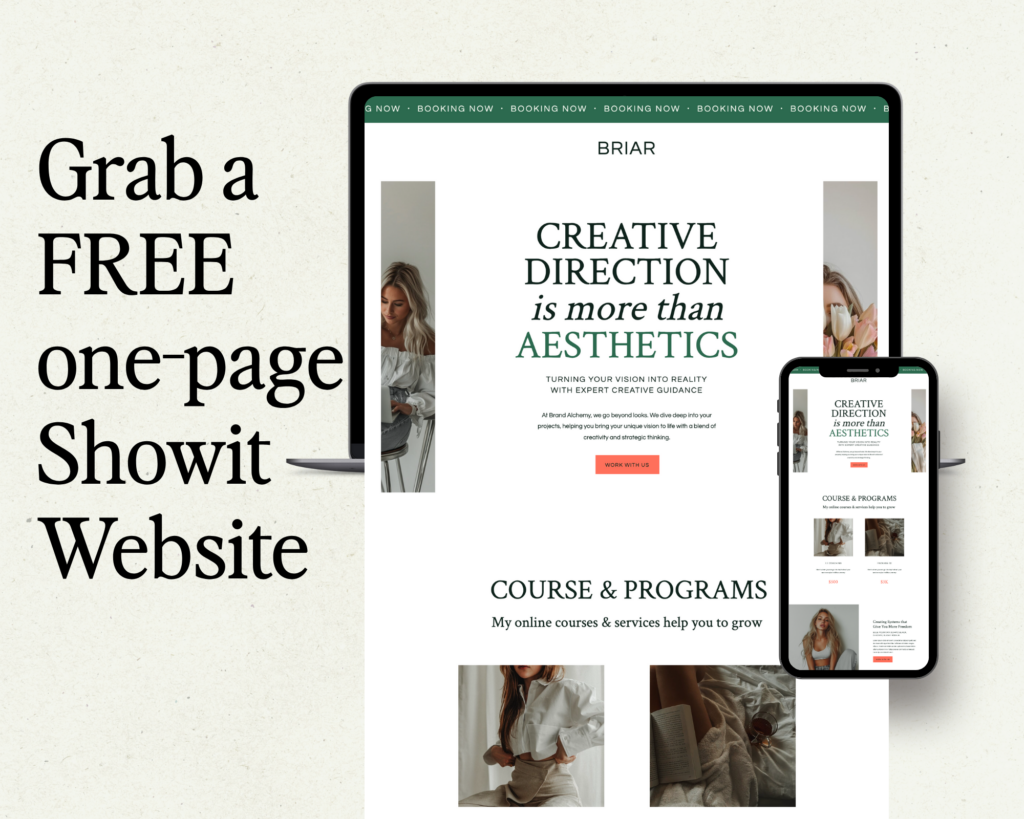
Your Free Starting Point: One-Page Template
Ready to start building but feeling overwhelmed by all the decisions? I’ve created a free one-page Showit template that gives you everything you need to get started immediately.
This isn’t just a basic template—it’s strategically designed to help coaches start converting visitors into consultation bookings from day one. It includes:
- Professional design that builds trust with potential clients
- Strategic layout that guides visitors toward booking a consultation
- Mobile optimization so it works perfectly on phones and tablets
- Easy customization so you can make it uniquely yours
- Complete instructions for setup and customization
The template gives you a feel for how Showit works without any risk or investment. As your business grows, you can expand it into a full multi-page website or upgrade to one of my signature templates that include comprehensive guides on using AI to write website copy that sounds authentically like you.
